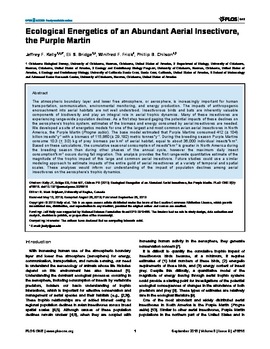| dc.contributor.author | Jeffrey F. Kelly | en_US |
| dc.contributor.author | Eli S. Bridge | en_US |
| dc.contributor.author | Winifred F. Frick | en_US |
| dc.contributor.author | Phillip B. Chilson | en_US |
| dc.date.accessioned | 2015-01-23T17:17:47Z | |
| dc.date.accessioned | 2016-03-30T15:36:17Z | |
| dc.date.available | 2015-01-23T17:17:47Z | |
| dc.date.available | 2016-03-30T15:36:17Z | |
| dc.date.issued | 2013-09-25 | en_US |
| dc.identifier.citation | Kelly JF, Bridge ES, Frick WF, Chilson PB (2013) Ecological Energetics of an Abundant Aerial Insectivore, the Purple Martin. PLoS ONE 8(9): e76616. doi:10.1371/journal.pone.0076616 | en_US |
| dc.identifier.uri | https://hdl.handle.net/11244/14097 | |
| dc.description | We thank T. Fagin for help with estimating the seasonal range area occupied by Purple Martins. We thank an anonymous reviewer, Mark Brigham, and J Boyles for their comments on this manuscript. | en_US |
| dc.description | Conceived and designed the experiments: JFK ESB WFF PBC. Performed the experiments: JFK PBC. Analyzed the data: JFK PBC. Wrote the manuscript: JFK ESB WFF PBC. Developed the model in Matlab: JFK PBC. | en_US |
| dc.description.abstract | The atmospheric boundary layer and lower free atmosphere, or aerosphere, is increasingly important for human transportation, communication, environmental monitoring, and energy production. The impacts of anthropogenic encroachment into aerial habitats are not well understood. Insectivorous birds and bats are inherently valuable components of biodiversity and play an integral role in aerial trophic dynamics. Many of these insectivores are experiencing range-wide population declines. As a first step toward gaging the potential impacts of these declines on the aerosphere’s trophic system, estimates of the biomass and energy consumed by aerial insectivores are needed. We developed a suite of energetics models for one of the largest and most common avian aerial insectivores in North America, the Purple Martin (Progne subis). The base model estimated that Purple Martins consumed 412 (± 104) billion insects*y-1 with a biomass of 115,860 (± 29,192) metric tonnes*y-1. During the breeding season Purple Martins consume 10.3 (+ 3.0) kg of prey biomass per km3 of aerial habitat, equal to about 36,000 individual insects*km-3. Based on these calculations, the cumulative seasonal consumption of insects*km-3 is greater in North America during the breeding season than during other phases of the annual cycle, however the maximum daily insect consumption*km-3 occurs during fall migration. This analysis provides the first range-wide quantitative estimate of the magnitude of the trophic impact of this large and common aerial insectivore. Future studies could use a similar modeling approach to estimate impacts of the entire guild of aerial insectivores at a variety of temporal and spatial scales. These analyses would inform our understanding of the impact of population declines among aerial insectivores on the aerosphere’s trophic dynamics. | en_US |
| dc.language.iso | en_US | en_US |
| dc.publisher | PLos One | en_US |
| dc.relation.ispartofseries | PLoS ONE 8(9):e76616 | en_US |
| dc.relation.uri | http://www.plosone.org/article/info%3Adoi%2F10.1371%2Fjournal.pone.0076616 | en_US |
| dc.rights | Attribution 3.0 United States | en_US |
| dc.rights.uri | https://creativecommons.org/licenses/by/3.0/us/ | en_US |
| dc.subject | PLOS | en_US |
| dc.subject | Public Library of Science | en_US |
| dc.subject | Open Access | en_US |
| dc.subject | Open-Access | en_US |
| dc.subject | Science | en_US |
| dc.subject | Medicine | en_US |
| dc.subject | Biology | en_US |
| dc.subject | Research | en_US |
| dc.subject | Peer-review | en_US |
| dc.subject | Inclusive | en_US |
| dc.subject | Interdisciplinary | en_US |
| dc.subject | Ante-disciplinary | en_US |
| dc.subject | Physics | en_US |
| dc.subject | Chemistry | en_US |
| dc.subject | Engineering | en_US |
| dc.title | Ecological Energetics of an Abundant Aerial Insectivore, the Purple Martin | en_US |
| dc.type | Research Article | en_US |
| dc.description.peerreview | Yes | en_US |
| dc.description.peerreviewnotes | http://www.plosone.org/static/editorial#peer | en_US |
| dc.identifier.doi | 10.1371/journal.pone.0076616 | en_US |
| dc.rights.requestable | false | en_US |

